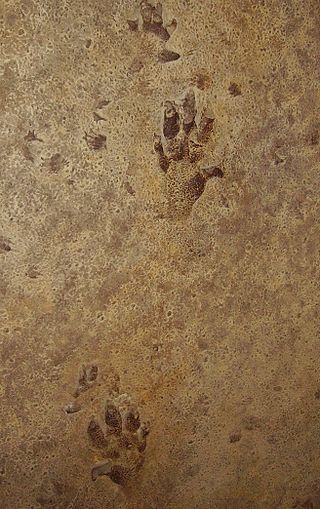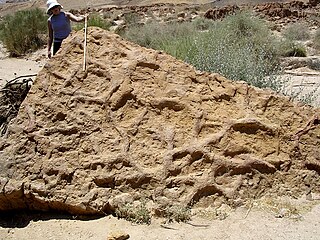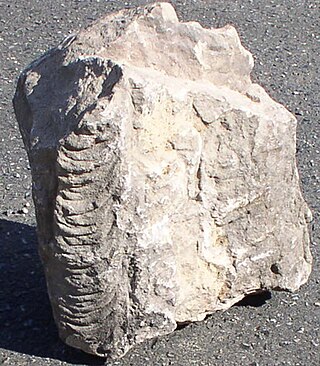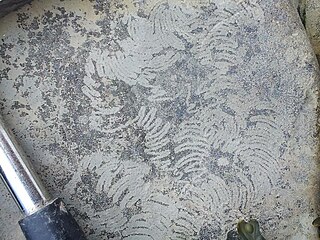
A trace fossil, also known as an ichnofossil, is a fossil record of biological activity by lifeforms but not the preserved remains of the organism itself. Trace fossils contrast with body fossils, which are the fossilized remains of parts of organisms' bodies, usually altered by later chemical activity or mineralization. The study of such trace fossils is ichnology and is the work of ichnologists.

Kimberella is an extinct genus of bilaterian known only from rocks of the Ediacaran period. The slug-like organism fed by scratching the microbial surface on which it dwelt in a manner similar to the gastropods, although its affinity with this group is contentious.

A burrow is a hole or tunnel excavated into the ground by an animal to construct a space suitable for habitation or temporary refuge, or as a byproduct of locomotion. Burrows provide a form of shelter against predation and exposure to the elements, and can be found in nearly every biome and among various biological interactions. Many animal species are known to form burrows. These species range from small amphipods, to very large vertebrate species such as the polar bear. Burrows can be constructed into a wide variety of substrates and can range in complexity from a simple tube a few centimeters long to a complex network of interconnecting tunnels and chambers hundreds or thousands of meters in total length; an example of the latter level of complexity, a well-developed burrow, would be a rabbit warren.

Treptichnus is the preserved burrow of an animal. As such, it is regarded as the earliest widespread complex trace fossil. Its earliest appearance, around 542 mya, which was contemporaneous with the last of the Ediacaran biota, is used to help define the dividing line, considered geologically at 541 mya, between the Ediacaran and Cambrian periods. It is last seen in the fossil record during the Cenomanian.
Trace fossils are classified in various ways for different purposes. Traces can be classified taxonomically, ethologically, and toponomically, that is, according to their relationship to the surrounding sedimentary layers. Except in the rare cases where the original maker of a trace fossil can be identified with confidence, phylogenetic classification of trace fossils is an unreasonable proposition.

Zoophycos is a somewhat cosmopolitan ichnogenus thought to be produced by moving and feeding polychaete worms.

Thalassinoides is an ichnogenus of trace fossil used to refer to "dichotomously or T-branched boxworks, mazes and shafts, unlined and unornamented". Facies of Thalassinoides increased suddenly in abundance at the beginning of the Mesozoic. Such burrows are made by a number of organisms, including the sea anemone Cerianthus, Balanoglossus and fishes, but are most closely associated with decapod crustaceans of the (former) infraorder Thalassinidea.

Paleodictyon is a trace fossil, usually interpreted to be a burrow, which appears in the geologic marine record beginning in the Precambrian/Early Cambrian and in modern ocean environments. Paleodictyon were first described by Giuseppe Meneghini in 1850. The origin of the trace fossil is enigmatic and numerous candidates have been proposed.
The Tumblagooda Sandstone is a geological formation deposited during the Silurian or Ordovician periods, between four and five hundred million years ago, and is now exposed on the west coast of Australia in river and coastal gorges near the tourist town of Kalbarri, Kalbarri National Park and the Murchison River gorge, straddling the boundary of the Carnarvon and Perth basins. Visible trackways are interpreted by some to be the earliest evidence of fully terrestrial animals.

Skolithos is a common trace fossil ichnogenus that is, or was originally, an approximately vertical cylindrical burrow with a distinct lining. It was produced globally by a variety of organisms, mostly in shallow marine environments, and appears as linear features in sedimentary rocks.

Rhizocorallium is an ichnogenus of burrow, the inclination of which is typically within 10° of the bedding planes of the sediment. These burrows can be very large, over a meter long in sediments that show good preservation, e.g. Jurassic rocks of the Yorkshire Coast, but the width is usually only up to 2 cm, restricted by the size of the organisms producing it. It is thought that they represent fodinichnia as the animal scoured the sediment for food.

An ichnofacies is an assemblage of trace fossils that provides an indication of the conditions that their formative organisms inhabited.

The "Cambrian substrate revolution" or "Agronomic revolution", evidenced in trace fossils, is a sudden diversification of animal burrowing during the early Cambrian period.

Diplocraterion is an ichnogenus describing vertical U-shaped burrows having a spreite between the two limbs of the U. The spreite of an individual Diplocraterion trace can be either protrusive or retrusive. Some ichnospecies have both types. The presence/absence of funnel-shaped openings should not be used as an ichnotaxobase due to the high probability that the upper portions of the trace may have been eroded away. Observation of the orientation of Diplocraterion in the field is frequently used to determine the way up of rock strata at outcrop.

A microbial mat is a multi-layered sheet of microorganisms, mainly bacteria and archaea, or bacteria alone. Microbial mats grow at interfaces between different types of material, mostly on submerged or moist surfaces, but a few survive in deserts. A few are found as endosymbionts of animals.
The Cambrian explosion, Cambrian radiation,Cambrian diversification, or the Biological Big Bang refers to an interval of time approximately 538.8 million years ago in the Cambrian Period of early Paleozoic when there was a sudden radiation of complex life and practically all major animal phyla started appearing in the fossil record. It lasted for about 13 – 25 million years and resulted in the divergence of most modern metazoan phyla. The event was accompanied by major diversification in other groups of organisms as well.

Ophiomorpha is an ichnotaxon, usually interpreted as a burrow of an organism living in the near-shore environment. The burrow lining is more or less smooth on the inside, and densely to strongly mammalated or nodose on the outside, due to the packing of nodules for support of the burrow. Branching is irregular but Y-shaped where present. It is often considered part of the Skolithos ichnofacies, where it has occurred since the early Permian, though it has also occurred in deep water settings since the Late Jurassic, such as well-oxygenated turbidites.

Chondrites is a trace fossil ichnogenus, preserved as small branching burrows of the same diameter that superficially resemble the roots of a plant. The origin of these structures is currently unknown. Chondrites is found in marine sediments from the Cambrian period of the Paleozoic onwards. It is especially common in sediments that were deposited in reduced-oxygen environments.

Nereites is a genus of trace fossil. Modern tracemakers of incipient Nereites include worm-like organisms, horseshoe crabs and hermit crabs. Traditionally, two models have been proposed for Nereites:
- in the ‘worm model’, Nereites is a feeding burrow produced by wormlike organisms, probing and backfilling laterally
- in the ‘arthropod model’, the characteristic lobes are pressure-release structures made by arthropod legs. According to this interpretation, Nereites is a locomotion trail

Spreite, meaning leaf-blade in German is a stacked, curved, layered structure that is characteristic of certain trace fossils. They are formed by invertebrate organisms tunneling back and forth through sediment in search of food. The organism moves perpendicularly just enough at the start of each back-and-forth pass so that it avoids reworking a previously tunneled area, thereby ensuring that it only makes feeding passes through fresh, unworked sediment.
















